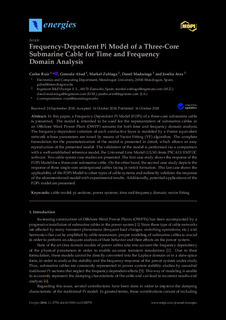Título
Frequency-Dependent Pi Model of a Three-Core Submarine Cable for Time and Frequency Domain AnalysisFecha de publicación
2018-10-16Grupo de investigación
Sistemas electrónicos de potencia aplicados al control de la energía eléctricaVersión
Version publicadaTipo de documento
ArtículoArtículoIdioma
engDerechos
© 2018 by the authorsAcceso
Acceso abiertoVersión de la editorial
https://doi.org/10.3390/en11102778Publicado en
Energies Vol. 11. Nº 10. 2778. Published 16 October 2018Editorial
MDPI AGPalabras clave
cable model
pi sections
power systems
time and frequency domain ... [+]
pi sections
power systems
time and frequency domain ... [+]
cable model
pi sections
power systems
time and frequency domain
vector fitting [-]
pi sections
power systems
time and frequency domain
vector fitting [-]
Resumen
In this paper, a Frequency-Dependent Pi Model (FDPi) of a three-core submarine cable is presented. The model is intended to be used for the representation of submarine cables in an Offshore Wind Power ... [+]
In this paper, a Frequency-Dependent Pi Model (FDPi) of a three-core submarine cable is presented. The model is intended to be used for the representation of submarine cables in an Offshore Wind Power Plant (OWPP) scenario for both time and frequency domain analysis. The frequency-dependent variation of each conductive layer is modeled by a Foster equivalent network whose parameters are tuned by means of Vector Fitting (VF) algorithm. The complete formulation for the parameterization of the model is presented in detail, which allows an easy reproduction of the presented model. The validation of the model is performed via a comparison with a well-established reference model, the Universal Line Model (ULM) from PSCAD/EMTDC software. Two cable system case studies are presented. The first case study shows the response of the FDPi Model for a three-core submarine cable. On the other hand, the second case study depicts the response of three single-core underground cables laying in trefoil formation. This last case shows the applicability of the FDPi Model to other types of cable systems and indirectly validates the response of the aforementioned model with experimental results. Additionally, potential applications of the FDPi model are presented. [-]
Colecciones
- Artículos - Ingeniería [756]
El ítem tiene asociados los siguientes ficheros de licencia:






















